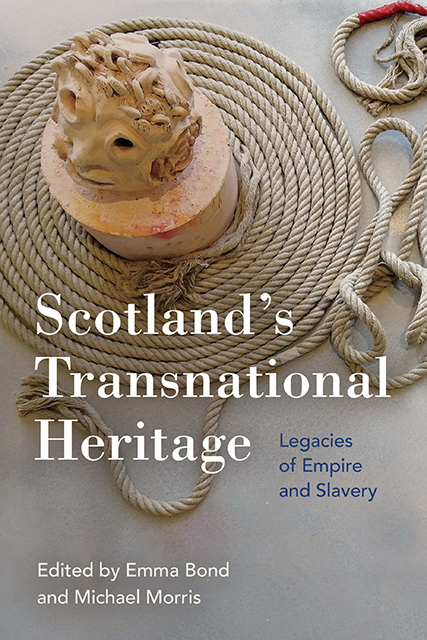197 results
List of Figures
-
- Book:
- Scotland's Transnational Heritage
- Published by:
- Edinburgh University Press
- Published online:
- 25 October 2023
- Print publication:
- 31 January 2023, pp vii-viii
-
- Chapter
- Export citation
Chapter 13 - Avowing Slavery in the Visual Arts
-
-
- Book:
- Scotland's Transnational Heritage
- Published by:
- Edinburgh University Press
- Published online:
- 25 October 2023
- Print publication:
- 31 January 2023, pp 200-217
-
- Chapter
- Export citation

Scotland's Transnational Heritage
- Legacies of Empire and Slavery
-
- Published by:
- Edinburgh University Press
- Published online:
- 25 October 2023
- Print publication:
- 31 January 2023
Part III - Transnational Time(s)
-
- Book:
- Scotland's Transnational Heritage
- Published by:
- Edinburgh University Press
- Published online:
- 25 October 2023
- Print publication:
- 31 January 2023, pp 155-156
-
- Chapter
- Export citation
Frontmatter
-
- Book:
- Scotland's Transnational Heritage
- Published by:
- Edinburgh University Press
- Published online:
- 25 October 2023
- Print publication:
- 31 January 2023, pp i-iv
-
- Chapter
- Export citation
Acknowledgements
-
- Book:
- Scotland's Transnational Heritage
- Published by:
- Edinburgh University Press
- Published online:
- 25 October 2023
- Print publication:
- 31 January 2023, pp xiii-xiv
-
- Chapter
- Export citation
Part I - Transnational Sites
-
- Book:
- Scotland's Transnational Heritage
- Published by:
- Edinburgh University Press
- Published online:
- 25 October 2023
- Print publication:
- 31 January 2023, pp 21-22
-
- Chapter
- Export citation
Contents
-
- Book:
- Scotland's Transnational Heritage
- Published by:
- Edinburgh University Press
- Published online:
- 25 October 2023
- Print publication:
- 31 January 2023, pp v-vi
-
- Chapter
- Export citation
Part II - Transnational Things
-
- Book:
- Scotland's Transnational Heritage
- Published by:
- Edinburgh University Press
- Published online:
- 25 October 2023
- Print publication:
- 31 January 2023, pp 87-88
-
- Chapter
- Export citation
Index
-
- Book:
- Scotland's Transnational Heritage
- Published by:
- Edinburgh University Press
- Published online:
- 25 October 2023
- Print publication:
- 31 January 2023, pp 235-242
-
- Chapter
- Export citation
Notes on Contributors
-
- Book:
- Scotland's Transnational Heritage
- Published by:
- Edinburgh University Press
- Published online:
- 25 October 2023
- Print publication:
- 31 January 2023, pp ix-xii
-
- Chapter
- Export citation
2 - Where We Need to Drive Food-System Action
-
-
- Book:
- Transforming Food Systems Under Climate Change through Innovation
- Published online:
- 19 January 2023
- Print publication:
- 19 January 2023, pp 11-22
-
- Chapter
-
- You have access
- Open access
- HTML
- Export citation
4 - Parenting and Children’s Social and Emotional Development: Emotion Socialization across Childhood and Adolescence
- from Part I - Foundations of Parenting
-
-
- Book:
- The Cambridge Handbook of Parenting
- Published online:
- 01 December 2022
- Print publication:
- 15 December 2022, pp 71-94
-
- Chapter
- Export citation
Mind, World and Value
-
-
- Book:
- The Philosophy of Mind
- Published online:
- 19 May 2022
- Print publication:
- 09 June 2022, pp 476-505
-
- Chapter
- Export citation
Identification and description of patients with multisystem inflammatory syndrome in adults associated with SARS-CoV-2 infection using the Premier Healthcare Database
-
- Journal:
- Epidemiology & Infection / Volume 150 / 2022
- Published online by Cambridge University Press:
- 17 January 2022, e26
-
- Article
-
- You have access
- Open access
- HTML
- Export citation
Primary school education resources on conservation in New Zealand over-emphasise killing of non-native mammals
-
- Journal:
- Australian Journal of Environmental Education / Volume 38 / Issue 2 / June 2022
- Published online by Cambridge University Press:
- 16 December 2021, pp. 168-177
-
- Article
-
- You have access
- Open access
- HTML
- Export citation
Coronavirus disease 2019 (COVID-19) screening system utilizing daily symptom attestation helps identify hospital employees who should be tested to protect patients and coworkers
- Part of
-
- Journal:
- Infection Control & Hospital Epidemiology / Volume 43 / Issue 11 / November 2022
- Published online by Cambridge University Press:
- 10 November 2021, pp. 1656-1660
- Print publication:
- November 2022
-
- Article
- Export citation
Visualising the proximal urethra by MRI voiding scan: results of a prospective clinical trial evaluating a novel approach to radiotherapy simulation for prostate cancer
-
- Journal:
- Journal of Radiotherapy in Practice / Volume 21 / Issue 4 / December 2022
- Published online by Cambridge University Press:
- 05 April 2021, pp. 472-475
-
- Article
-
- You have access
- Open access
- HTML
- Export citation
Variational assimilation of web camera-derived estimates of visibility for Alaska aviation
-
- Journal:
- Experimental Results / Volume 2 / 2021
- Published online by Cambridge University Press:
- 15 March 2021, e14
-
- Article
-
- You have access
- Open access
- HTML
- Export citation
Rapid Integrated Healthcare Response for the First US Evacuees from Wuhan, China, During the COVID-19 Pandemic
-
- Journal:
- Disaster Medicine and Public Health Preparedness / Volume 16 / Issue 4 / August 2022
- Published online by Cambridge University Press:
- 22 December 2020, pp. 1692-1694
-
- Article
-
- You have access
- Open access
- HTML
- Export citation



